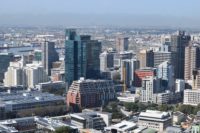Cape Town Sets Drought Measures
South Africa’s Cape Town—at nearly 4 million people, the country’s second-most populous city—could run out of water in the next three months if the current drought, the worst in 10 years, persists.
Municipal authorities put in place emergency measures on Jan. 18.
Mayor Patricia de Lille noted that, overall, the water level at six of the city’s water-supply dams have reached 28.1% and could hit 13.5% by April 21, dubbed Day Zero, when water taps are expected to shut. Residents will be rationed to 25 liters of water a day per person. Cape Town’s total daily water usage now is capped at 450 million liters.
Focus has shifted to advanced water-pressure management, more water-management devices at high-consumption properties, leak detection and treated effluent systems, offsetting the use of drinking water for non-potable purposes, the mayor said.
An estimated 63% of water supplied to Cape Town is used for domestic and industrial purposes, while 32% is taken up by irrigation; another 5% is directed to the towns of Stellenbosch, Paarl and Wellington and others in the West Coast and Swartland regions.
Cape Town’s Western Cape Water Supply System comprises a series of water pipelines, turbines and water-distribution networks combined with six dams. On the Sonderend River, the Theewaterskloof Dam is the largest dam, with a capacity of 480 million cu meters.
South Africa’s Dept. of Water Affairs noted that, at the end of 2017, the dam’s water level had reached 12.9%, with 10% of it unreachable.
The city is implementing different components of a $62.2-million water conservation-and-demand management strategy, launched in 2008. At least seven water-supply projects—four desalination plants, two groundwater-abstraction initiatives and one water-recycling project—are in the pipeline to add 200 million liters per day to the existing water-supply capacity.



